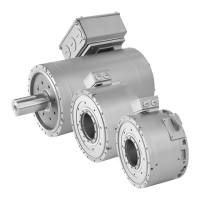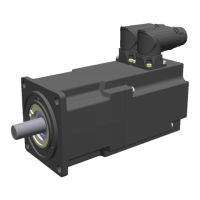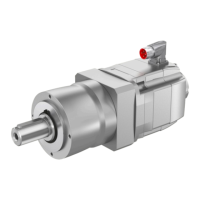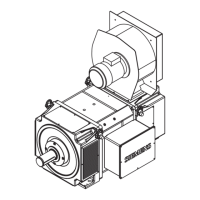Technical data and characteristics
6.1 Explanations of the formula abbreviations
1FW6 Built-in torque motors
Configuration Manual, 07/2017, 6SN1197-0AE00-0BP9
157
Insert the appropriate data from the Chapter "Data sheets and diagrams" into the following
formula. Conversion of the speed n from rpm to s
-1
and the power from W to kW has already
been taken into account.
MAX
Maximum permissible operating speed.
MAX,MMAX
Maximum speed at which the motor can supply the maximum torque M
MAX
Maximum speed, where a Voltage Protection Module VPM is not required.
MAX,0
No-load speed; max. speed without load.
0
= 1 rpm at which the load and power loss are still evenly
distributed across all three motor phases.
Current (rms value) of the motor at torque M
0
and speed n = 1 rpm.
0
Thermal static torque when the current is
unevenly distributed across the three
motor lines. An uneven current load occurs in the following operating modes:
Standstill
Operation with short cyclic rotations (< 1 pole pitch)
for n << 1 rpm
Since the saturation effect can be disregarded for the rated
current, the following
applies (approximately):
0
Thermal stall current (rms value) of the motor at M
0
*
. The following applies:
T,20
Motor torque constants at a rotor temperature of 20 °C (refers to the lower linear
range of the torque–current characteristic).
E
Voltage constants for calculating the mutually induced line-to-line voltage.
M,20
Motor constant for a winding temperature of T
= 20 °C.
M
(T) can be calculated for other temperatures:
M
(T) = k
M,20
∙ [1 + α(T – 20 °C)]
using the temperature coefficients α
= −0.001 1/K for magnets
M
M,20
∙ [1 - 0.001 ∙ (T – 20 °C)]
TH
Thermal time constant of the motor winding. This is derived from the temperature
characteristic in the winding with a
sudden load and constant current. See diagram
TH
has elapsed, the motor winding reaches approx. 63 % of its
GRENZ
, if the thermal protection does not respond beforehand.

